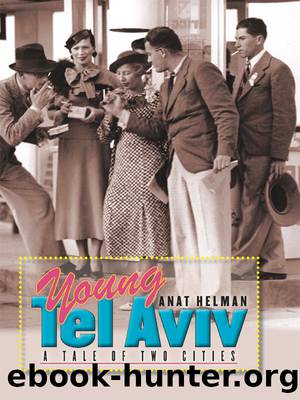Young Tel Aviv by Helman Anat;Watzman Haim;Watzman Professor Haim;Helman Anat;

Author:Helman, Anat;Watzman, Haim;Watzman, Professor Haim;Helman, Anat; [Helman, Anat]
Language: eng
Format: epub
ISBN: 1084918
Publisher: Brandeis University Press
Something for Everyone
As work hours became confined to just one part of the day and modern Westernersâ buying power increased, the importance of leisure culture grew. Many leisure activities became part of the economy, since they involved the purchase of goods and services. New forms of leisure were to a large extent an urban phenomenon. The growth of cities, along with their density and heterogeneity, encouraged the establishment of official institutions and services devoted to entertainment and amusement. In addition to providing diversion and enjoyment, citiesâ leisure activities helped crystallize identities, served as a force for social cohesion, and enhanced the attraction of city life.6
During the evening and at night, Tel Avivâs main streets became filled with residents and tourists out to consume the cityâs high culture and diversions, or simply to stroll along the roads or the beach. At the beginning of the 1920s, the municipal police chief expressed concern about crowding in places of entertainment, caused in part by the tendency among establishment owners to sell more tickets than their halls could accommodate, and also by the habit among policemen charged with keeping order outdoors to go inside and enjoy the shows and parties. Shoe shiners, as noted already, made most of their money at night from clients on their way to events and parties. Soft drink peddlers also waited eagerly for nighttime, when thirsty audiences and partygoers headed home. Tel Avivâs hot, humid summer nights drew people out into the street in a desperate search for a cool breeze. A British police officer asserted that the summer heat made it impossible to stay at home. Leisure pursuits in Tel Aviv were thus conducted largely outside, or in the cityâs generous selection of popularly priced restaurants and cafés.7
Marcia Gitlin listed the available evening pastimes: the movies, theater, musical recitals, lectures, social visits, or a walk along Allenby Street to the beach, a route lined with teahouses and fashionable hotels. Gitlin was disappointed to discover that, except for the Hebrew-speaking theater, most of Tel Avivâs leisure activities were hardly unique. The cafés were âEuropean-style,â and even the films resembled those in Cape Town, except that they had subtitles in English, Arabic, and Hebrew. The poet Natan Alterman described these places of amusement as drab in the morning glare as opposed to âwhen the day goes dark, when the bright lamps are lit on their fences.â Then they came to life, giving the old peddler his livelihood and filling the street with melodies blaring from loudspeakers and the aroma of roasted peanuts. In the light of morning, Alterman wrote, Tel Aviv looked like a humdrum, workaday city, but enrobed in magical electric lights, it was transformed in form and essence each evening. A journalist, Uri Kesari, wrote that 9 p.m. was the hour at which reality metamorphosed into a land of desires and illusions.8 The Tel Aviv municipality took a more practical approach to the cityâs nightlifeâit imposed a differential tax on the price of event tickets, to the benefit of high culture.
Download
This site does not store any files on its server. We only index and link to content provided by other sites. Please contact the content providers to delete copyright contents if any and email us, we'll remove relevant links or contents immediately.
| African | Asian |
| Canadian | Caribbean & West Indian |
| European | International |
| Latin American | Mexican |
| Middle Eastern | Native American |
| U.S. Regional |
Biscuits: A Savor the South Cookbook by Belinda Ellis(4290)
The French Women Don't Get Fat Cookbook by Mireille Guiliano(3606)
A Jewish Baker's Pastry Secrets: Recipes from a New York Baking Legend for Strudel, Stollen, Danishes, Puff Pastry, and More by George Greenstein(3545)
Better Homes and Gardens New Cookbook by Better Homes & Gardens(3525)
Ottolenghi Simple by Yotam Ottolenghi(3515)
Al Roker's Hassle-Free Holiday Cookbook by Al Roker(3499)
Trullo by Tim Siadatan(3379)
Bake with Anna Olson by Anna Olson(3357)
Hot Thai Kitchen by Pailin Chongchitnant(3320)
Panini by Carlo Middione(3252)
Nigella Bites (Nigella Collection) by Nigella Lawson(3173)
Momofuku by David Chang(3140)
Salt, Fat, Acid, Heat: Mastering the Elements of Good Cooking by Nosrat Samin(3108)
Modern French Pastry: Innovative Techniques, Tools and Design by Cheryl Wakerhauser(3076)
Best of Jane Grigson by Jane Grigson(2946)
Classic by Mary Berry(2942)
Solo Food by Janneke Vreugdenhil(2930)
Tapas Revolution by Omar Allibhoy(2929)
Ottolenghi - The Cookbook by Yotam Ottolenghi(2871)
